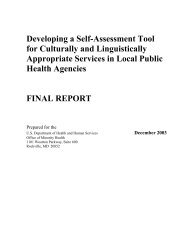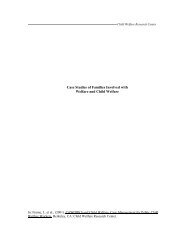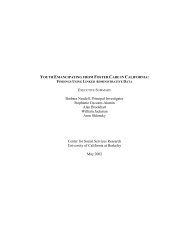Family Assessment in Child Welfare - Center for Social Services ...
Family Assessment in Child Welfare - Center for Social Services ...
Family Assessment in Child Welfare - Center for Social Services ...
You also want an ePaper? Increase the reach of your titles
YUMPU automatically turns print PDFs into web optimized ePapers that Google loves.
In summary, of the seven most promis<strong>in</strong>g assessment <strong>in</strong>struments, the NCFAS, theNCFAS-R, and the FAF appear to be the most relevant <strong>for</strong> use <strong>in</strong> child welfare sett<strong>in</strong>gs, despitesome of their psychometric limitations. The NCFAS <strong>in</strong>struments utilize a strengths-basedorientation and have been extensively tested with child welfare populations. The FAF wasdesigned <strong>for</strong> child welfare sett<strong>in</strong>gs and has been used <strong>in</strong> several jurisdictions over the past tenyears. Software versions of the FAF offer benefits that should be of <strong>in</strong>terest to child welfaremanagers. The Darl<strong>in</strong>gton <strong>Family</strong> <strong>Assessment</strong> System (DFAS) also appears promis<strong>in</strong>g given itsmulti-system, multi-method approach, which mirrors the family assessment process <strong>in</strong> childwelfare by us<strong>in</strong>g multiple methods to ga<strong>in</strong> multiple perspectives <strong>in</strong> a case. It has excellentpsychometric properties and is comprehensive <strong>in</strong> nature. However, more research is needed toestablish its validity with child welfare populations and to evaluate its feasibility due to lengthyadm<strong>in</strong>istration time.Patterns of <strong>Social</strong> Interaction and SupportWe identified four measures <strong>for</strong> specialized assessment <strong>for</strong> use at multiple po<strong>in</strong>ts <strong>in</strong> thelife of the case that focus on patterns of social <strong>in</strong>teraction (<strong>in</strong>clud<strong>in</strong>g the nature of contact and<strong>in</strong>volvement with others, and the presence or absence of social support networks andrelationships at multiple po<strong>in</strong>ts <strong>in</strong> the life of the case). As noted <strong>in</strong> Figure 5, these <strong>in</strong>struments<strong>in</strong>clude the McMaster Model, the <strong>Assessment</strong> of Strategies <strong>in</strong> Families-Effectiveness (ASF-E),the Circumplex Model, and the <strong>Family</strong> <strong>Assessment</strong> Measure III.Figure 5. Promis<strong>in</strong>g Measures of <strong>Social</strong> InteractionInstrumentIntake/Screen<strong>in</strong>g<strong>Child</strong> <strong>Welfare</strong> Decision/Stage of <strong>Assessment</strong>Investigation/DiagnosisCasePlann<strong>in</strong>gCont<strong>in</strong>u<strong>in</strong>g<strong>Services</strong>,Placement &Reunification/Monitor<strong>in</strong>g &EvaluationMcMaster Model X X X X<strong>Assessment</strong> of Strategies <strong>in</strong> Families-Effectiveness (ASF-E)X X XCircumplex Model X X X<strong>Family</strong> <strong>Assessment</strong> Measure III X XX = child welfare decision/stage of assessment <strong>for</strong> which <strong>in</strong>strument is used15
















